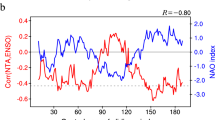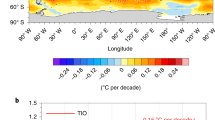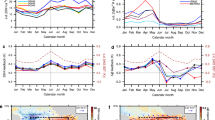Abstract
The Atlantic Niño/Niña is a dominant mode of interannual variability peaking in boreal summer with substantial climate impacts. How the Atlantic Niño/Niña sea surface temperature (SST) variability may change under greenhouse warming remains unclear. Here we find a robust suppression in future Atlantic Niño/Niña variability in models that simulate a reasonable mean climatology of the equatorial Atlantic. Under greenhouse warming, the equatorial Atlantic atmosphere becomes more stable, reducing sensitivity of the equatorial zonal winds to the zonal SST gradient; further, weakened trade winds lead to a deepened thermocline in the east, reducing SST sensitivity to thermocline anomalies. These changes feed into Bjerknes feedback to cause suppression in Atlantic Niño/Niña SST variability. These findings are in stark contrast to the Pacific and the Indian Ocean where El Niño/La Niña SST variability and strong Indian Ocean Dipole variability are projected to increase.
This is a preview of subscription content, access via your institution
Access options
Access Nature and 54 other Nature Portfolio journals
Get Nature+, our best-value online-access subscription
$29.99 / 30 days
cancel any time
Subscribe to this journal
Receive 12 print issues and online access
$209.00 per year
only $17.42 per issue
Buy this article
- Purchase on Springer Link
- Instant access to full article PDF
Prices may be subject to local taxes which are calculated during checkout





Similar content being viewed by others
Data availability
All datasets related to this paper are publicly available and can be downloaded from the following websites: HadISSTv1.1 (http://hadobs.metoffice.com/hadisst/data/download.html), SODA 2.2.4 (http://apdrc.soest.hawaii.edu/las/v6/dataset?catitem=4782), NCEP/NCAR Reanalysis 1 (https://psl.noaa.gov/data/gridded/data.ncep.reanalysis.html), CMIP6 (Supplementary Tables 1 and 2) (https://pcmdi.llnl.gov/CMIP6/) and CESM-HR transient simulations from iHESP (https://ihesp.github.io/archive/products/ihesp-products/data-release/DataRelease_Phase2.html).
Code availability
The code for conducting the bootstrap test is publicly available via Zenodo at https://doi.org/10.5281/zenodo.6791870 (ref. 47). All other codes are available from the corresponding author on request.
References
Xie, S. P. & Carton, J. A. Tropical Atlantic variability: patterns, mechanisms, and impacts. Am. Geophys. Union 147, 121–142 (2004).
Lübbecke, J. F. et al. Equatorial Atlantic variability—modes, mechanisms, and global teleconnections. WIREs Clim. Change 9, e527 (2018).
Richter, I. & Tokinaga, H. in Tropical and Extratropical Air–Sea Interactions: Modes of Climate Variations (ed. Behera, S. K.) 171–206 (Elsevier, 2021).
Hastenrath, S. Interannual variability and annual cycle: mechanisms of circulation and climate in the tropical Atlantic sector. Mon. Weath. Rev. 112, 1097–1107 (1984).
Okumura, Y. & Xie, S. P. Interaction of the Atlantic equatorial cold tongue and African monsoon. J. Clim. 19, 5859–5874 (2004).
Nobre, P. & Shukla, J. Variations of sea surface temperature, wind stress, and rainfall over the tropical Atlantic and South America. J. Clim. 9, 2464–2479 (1996).
Kucharski, F., Bracco, A., Yoo, J. H. & Moltini, F. Low–frequency variability of the Indian monsoon ENSO relationship and the tropical Atlantic: the weakening of the 1980s and 1990s. J. Clim. 20, 4255–4266 (2007).
Losada, T., Rodríguez–Fonseca, B. & Kucharski, F. Tropical influence on the summer Mediterranean climate. Atmos. Sci. Lett. 13, 36–42 (2012).
Cai, W. et al. Pantropical climate interactions. Science 363, eaav4236 (2019).
Rodríguez–Fonseca, B. et al. Are Atlantic Niños enhancing Pacific ENSO events in recent decades? Geophys. Res. Lett. 36, L20705 (2009).
Ham, Y. G., Kug, J. S. & Park, J. Y. Two distinct roles of Atlantic SSTs in ENSO variability: north tropical Atlantic SST and Atlantic Niño. Geophys. Res. Lett. 40, 4012–4017 (2013).
Jia, F. et al. Weakening Atlantic Niño–Pacific connection under greenhouse warming. Sci. Adv. 5, eaax4111 (2019).
Keenlyside, N. S., Ding, H. & Latif, M. Potential of equatorial Atlantic variability to enhance El Niño prediction. Geophys. Res. Lett. 40, 2278–2283 (2013).
Zebiak, S. E. Air–sea interaction in the equatorial Atlantic region. J. Clim. 6, 1567–1586 (1993).
Keenlyside, N. S. & Latif, M. Understanding equatorial Atlantic interannual variability. J. Clim. 20, 131–142 (2007).
Xie, S. –P. & Philander, S. G. H. A coupled ocean–atmosphere model of relevance to the ITCZ in the eastern Pacific. Tellus 46, 340–350 (1994).
Dippe, T., Greatbatch, R. J. & Ding, H. On the relationship between Atlantic Niño variability and ocean dynamics. Clim. Dyn. 51, 597612 (2017).
Jouanno, J., Hernandez, O. & Sanchez–Gomez, E. Equatorial Atlantic interannual variability and its relation to dynamic and thermodynamic processes. Earth Syst. Dyn. 8, 1061–1069 (2017).
Amaya, D. J., DeFlorio, M. J., Miller, A. J. & Xie, S.–P. WES feedback and the Atlantic Meridional Mode: observations and CMIP5 comparisons. Clim. Dyn. 49, 1665–1679 (2016).
Yang, Y., Xie, S., Wu, L., Kosoka, Y. & Li, J. ENSO forced and local variability of north tropical Atlantic SST: model simulations and biases. Clim. Dyn. 51, 4511–4524 (2018).
Nnamchi, H. C. et al. Thermodynamic controls of the Atlantic Niño. Nat. Commun. 6, 88–95 (2015).
Nnamchi, H. C. et al. An equatorial extratropical dipole structure of the Atlantic Niño. J. Clim. 29, 7295–7311 (2016).
Tokinaga, H. & Xie, S. P. Weakening of the equatorial Atlantic cold tongue over the past six decades. Nat. Geosci. 4, 222–226 (2011).
Prigent, A., Lübbecke, J. F., Bayr, T., Latif, M. & Wengel, C. Weakened SST variability in the tropical Atlantic Ocean since 2000. Clim. Dyn. 54, 2731–2744 (2020).
Nnamchi, H. C., Latif, M., Keenlyside, N. S. & Park, W. A satellite era warming hole in the equatorial Atlantic Ocean. J. Geophys. Res. Oceans 125, e2019JC015834 (2020).
Chang, C. Y., Carton, J. A., Grodsky, S. A. & Nigam, S. Seasonal climate of the tropical Atlantic sector in the NCAR Community Climate System Model 3: error structure and probable causes of errors. J. Clim. 20, 1053–1070 (2007).
Yang, Y., Xie, S. P., Wu, L., Kosaka, Y. & Li, J. Causes of enhanced SST variability over the equatorial Atlantic and its relationship to the Atlantic zonal mode in CMIP5. J. Clim. 30, 6171–6182 (2017).
Richter, I. & Xie, S. P. On the origin of equatorial Atlantic biases in coupled general circulation models. Clim. Dyn. 31, 587–598 (2008).
Richter, I., Xie, S. P., Behera, S. K., Doi, T. & Masumoto, Y. Equatorial Atlantic variability and its relation to mean state biases in CMIP5. Clim. Dyn. 42, 171–188 (2014).
Richter, I. & Tokinaga, H. An overview of the performance of CMIP6 models in the tropical Atlantic: mean state, variability, and remote impacts. Clim. Dyn. 55, 2579–2601 (2020).
Doi, T., Vecchi, G., Rosati, A. & Delworth, T. Biases in the Atlantic ITCZ in seasonal–interannual variations for a coarse- and a high-resolution coupled climate model. J. Clim. 25, 5494–5511 (2012).
Harlaß, J., Latif, M. & Park, W. Improving climate model simulation of tropical Atlantic sea surface temperature: the importance of enhanced vertical atmosphere model resolution. Geophys. Res. Lett. 42, 2401–2408 (2015).
Harlaß, J., Latif, M. & Park, W. Alleviating tropical Atlantic sector biases in the Kiel climate model by enhancing horizontal and vertical atmosphere model resolution: climatology and interannual variability. Clim. Dyn. 50, 2605–2635 (2017).
Worou, K., Goosse, H., Fichefet, T. & Kucharski, F. Weakened impact of the Atlantic Niño on the future equatorial Atlantic and Guinea Coast rainfall. Earth Syst. Dynam. 13, 231–249 (2022).
Eyring, V. et al. Overview of the Coupled Model Intercomparison Project phase 6 (CMIP6) experimental design and organization. Geosci. Model Dev. 9, 1937–1958 (2016).
Chang, P. S. et al. An unprecedented set of high-resolution Earth system simulations for understanding multiscale interactions in climate variability and change. J. Adv. Model Earth Syst. 12, e2020MS002298 (2020).
Wang, S. et al. El Niño/Southern Oscillation inhibited by submesoscale ocean eddies. Nat. Geosci. 15, 112–117 (2022).
Vecchi, G. A. & Soden, B. J. Global warming and the weakening of the tropical circulation. J. Clim. 20, 4316–4340 (2007).
Xie, S. P. et al. Global warming pattern formation: sea surface temperature and rainfall. J. Clim. 23, 966–986 (2010).
Cai, W. et al. Increased ENSO sea surface temperature variability under four IPCC emission scenarios. Nat. Clim. Change 12, 228–231 (2022).
Cai, W. et al. in Indian Summer Monsoon Variability: El Niño Teleconnections and Beyond (eds Chowdary, J. et al.) Ch. 21 (Elsevier, 2021).
Rayner, N. A. et al. Global analyses of sea surface temperature, sea ice, and night marine air temperature since the late nineteenth century. J. Geophys. Res. 108, 4407 (2003).
Kalnay, E. et al. The NCEP/NCAR 40-year reanalysis project. Bull. Am. Meteorol. Soc. 77, 437–472 (1996).
Giese, B. S. & Ray, S. El Niño variability in simple ocean data assimilation (SODA), 1871–2008. J. Geophys. Res. 116, 6695 (2011).
Austin, P. C. & Tu, J. V. Bootstrap methods for developing predictive models. Am. Stat. 58, 131–137 (2004).
Yang, Y. et al. Greenhouse warming intensifies north tropical Atlantic climate variability. Sci. Adv. 7, eabg9690 (2021).
Yang, Y. et al. Suppressed Atlantic Niño/Niña variability under greenhouse warming. Zenodo https://doi.org/10.5281/zenodo.6791870 (2022).
Acknowledgements
This work is supported by the National Natural Science Foundation of China (NSFC) project (grant nos. 41976005, 41876008, 41730534), Strategic Priority Research Program of Chinese Academy of Sciences (XDB40000000). W.C., B.N. and G.W. are supported by the Centre for Southern Hemisphere Oceans Research, a joint research centre between QNLM and CSIRO. G.W. is also supported by the Australian government under the National Environmental Science Program. F.J. is supported by the National Key Research and Development Program of China (2020YFA0608801) and Youth Innovation Promotion Association of Chinese Academy of Sciences (2021205). Y.Y. is supported by the Fundamental Research Funds for the Central Universities. Computation is supported by the Center for High Performance Computing and System Simulation, Pilot National Laboratory for Marine Science and Technology (Qingdao).
Author information
Authors and Affiliations
Contributions
Y.Y. conceived and wrote the initial manuscript in discussion with L.W. and W.C.; Y.Y., F.J., G.W., B.N. and T.G. conducted the analysis. All authors contributed to improving the manuscript.
Corresponding authors
Ethics declarations
Competing interests
The authors declare no competing interests.
Peer review
Peer review information
Nature Climate Change thanks the anonymous reviewers for their contribution to the peer review of this work.
Additional information
Publisher’s note Springer Nature remains neutral with regard to jurisdictional claims in published maps and institutional affiliations.
Extended data
Extended Data Fig. 1 Climatological equatorial Atlantic temperatures.
a, Climatological JJA temperatures (°C) averaged over the 3°S-3°N region during the period of 1950 to 1999 in an ocean reanalysis, referred to as Simple Ocean Data Assimilation (SODA)44. b, West-minus-east equatorial Atlantic Z20 gradient (m), defined as difference in Z20 between averages over the western (3°S-3°N, 30°W-50°W) and eastern (3°S-3°N, 15°W-5°E) equatorial Atlantic in SODA (red-filled bar) and all climate models. The model (HadGEM3-GC31-MM) that fails to reproduce Bjerknes feedback is greyed out and excluded from the selected model group. The selected models are indicated by blue-filled-non-greyed-out bars. Models to the right of the vertical line are not selected. The red dashed lines represent the multi-model ensemble means of the selected and non-selected models, respectively. c, d, Same as (a) but for ensemble mean of selected (c) and non-selected models (d). The black thick lines in (a, c, d) represent Z20. e, Same as (b) but for Z20 in the eastern (3°S-3°N, 15°W-5°E) equatorial Atlantic. Only models with available outputs are shown.
Extended Data Fig. 2 Observed and modeled anomaly pattern of Atlantic Niño.
a, Total response of SST to ATL3 (°C) in HadISST42. b, Standard variability of ATL3 (°C) in HadISST (red-filled bar) and all climate models. The selected models are indicated by blue-filled bars. Models to the right of the vertical line are not selected. The red dashed lines represent the multi-model ensemble means of the selected and non-selected models, respectively. c, d, Same as (a) but for ensemble means of selected (c) and non-selected models (d).
Extended Data Fig. 3 Projected change in variability of SST gradient and SSH sensitivity to wind.
a, Comparison of normalized ∇SST variability (s.d.) over the 20th (blue-edged bars) and 21st (red-edged bars) century for the 25 selected models. The multi-model ensemble means over each period are shown in blue-filled and red-filled bars, respectively; error bars are calculated as 1.0 s.d. of a total of 10,000 inter-realizations of a bootstrap method (see Method section ‘Bootstrap test’); models that simulate an increase are greyed out. Vertical line separates the CMIP6-HighResMIP (right) from the other (left) models. b, Same as (a), but for SSHCT sensitivity to UWAtl (s). Only models with available outputs are shown.
Extended Data Fig. 4 Projected decrease in occurrences of extreme Atlantic Niño/Niña events.
a, Comparison of the number of extreme events, defined as normalized |ATL3| > 1.5 s.d., over the 20th (blue-edged bars) and 21st (red-edged bars) century for the 25 selected models. The multi-model ensemble means over each period are shown in blue-filled and red-filled bars, respectively; error bars are calculated as 1.0 s.d. of a total of 10,000 inter-realizations of a bootstrap method (see Method section ‘Bootstrap test’); models that simulate an increase are greyed out. Vertical line separates the CMIP6-HighResMIP (right) from the other (left) models. b, Same as (a), but for a threshold of |ATL3| > 1.75 s.d..
Extended Data Fig. 5 Projected flattening of equatorial Atlantic thermocline in the selected models.
a, Ensemble mean of scaled difference in climatological Z20 (m per °C of global SST warming) in JJA. We calculate Z20 difference between the 21st and 20th century for each model. We then scale this difference by the increase of global mean SST simulated in each individual model before taking ensemble mean of the scaled Z20 and average over the selected models. b, Comparison of Z20 gradient (m) over the 20th (blue-edged bars) and the 21st (red-edged bars) century for the selected models. The multi-model ensemble means over the 20th and 21st century are shown in blue-filled and red-filled bars, respectively; error bars are calculated as 1.0 s.d. of a total of 10,000 inter-realizations of a bootstrap method; models that simulate an increase are greyed out. Vertical line separates the CMIP6-HighResMIP (right) from the other (left) models. c, Histograms of 10,000 realizations of the Bootstrap method for Z20 gradient (m) in the 20th (blue) and 21st (red) century climate. The blue and red lines indicate the mean values of the 10,000 realizations for each period. The grey shaded areas refer to the respective 1.0 s.d. of the 10,000 realizations (see Method section ‘Bootstrap test’). Only models with available outputs are shown.
Extended Data Fig. 6 Impacts of MAM wind anomalies on JJA mean climatology in the selected models.
a Inter-model relationship between changes in MAM equatorial zonal wind (m s−1 per °C of global warming, 3°S-3°N, 40°W-10°E, black box in b) and Z20 gradient (m per °C of global warming) in JJA (a). A linear fit (black solid line) is shown together with the correlation coefficient R, slope, and P value from the regression. To enhance inter-model comparability, we scale the changes by increase in global mean SST of each model. The four models from CMIP6-HighResMIP are not included due to short integration time. b, Ensemble mean of scaled difference in climatological SST (°C per °C of global SST warming, color shading) and wind (m s−1 per °C of global SST warming, vector) in MAM. c, Same as (a), but for changes in MAM equatorial zonal wind (m s−1 per °C of global warming) and in JJA ∇SST (°C per °C of global warming). Please note that we only show available model outputs.
Extended Data Fig. 7 Projected weakening of the Atlantic cold tongue in the selected models.
Same as Extended Data Fig. 5, but for scaled difference of JJA SST (°C per °C of global SST warming, color shading) and wind (m s−1 per °C of global SST warming, vector) (a), and ∇SST (°C) (b, c). The green and black boxes in (a) represent western (3°S-3°N, 25°W-45°W) and eastern (3°S-3°N, 20°W-0°E) equatorial Atlantic, respectively.
Extended Data Fig. 8 Processes of stabilized atmosphere in affecting thermocline variability.
a, Inter-model relationship between changes in total response of UWAtl to ∇SST (m s−1 per °C of global warming) and in UWAtl variability (m s−1 per °C of global warming). A linear fit (black solid line) is shown together with the correlation coefficient R, slope, and P value from the regression. To enhance inter-model comparability, we scale the changes by increase in global mean SST of each model. The four models from CMIP6-HighResMIP are not included due to short length of integration. b, Same as a, but for changes in total response of SSHCT to UWAtl (m per °C of global warming) and in SSHCT variability (m per °C of global warming).
Extended Data Fig. 9 Changes in variability of three sensitivities involved in Bjerknes feedback under other emission scenarios.
(a-c) Comparisons of ATL3 sensitivity to SSHCT (°C m−1) over the 20th (x-axis) and 21st (y-axis) century for the selected models in SSP1-2.6 (left), SSP2-4.5 (middle), and SSP-3.70 (right) scenarios. Number of models that project an increase/decrease is shown in red/blue colors. (d-f) and (g-i), same as (a-c) but for UWAtl sensitivity to ∇SST (m s−1°C−1) (d-f) and SSHCT sensitivity to UWAtl (s) (g-i). Only models with available outputs are shown.
Supplementary information
Supplementary Information
Supplementary Figs. 1–4 and Tables 1 and 2.
Rights and permissions
Springer Nature or its licensor holds exclusive rights to this article under a publishing agreement with the author(s) or other rightsholder(s); author self-archiving of the accepted manuscript version of this article is solely governed by the terms of such publishing agreement and applicable law.
About this article
Cite this article
Yang, Y., Wu, L., Cai, W. et al. Suppressed Atlantic Niño/Niña variability under greenhouse warming. Nat. Clim. Chang. 12, 814–821 (2022). https://doi.org/10.1038/s41558-022-01444-z
Received:
Accepted:
Published:
Issue Date:
DOI: https://doi.org/10.1038/s41558-022-01444-z
This article is cited by
-
Future weakening of southeastern tropical Atlantic Ocean interannual sea surface temperature variability in a global climate model
Climate Dynamics (2024)
-
Southern hemisphere eastern boundary upwelling systems emerging as future marine heatwave hotspots under greenhouse warming
Nature Communications (2023)
-
Disentangling the impact of Atlantic Niño on sea-air CO2 flux
Nature Communications (2023)
-
Weakened interannual Tropical Atlantic variability in CMIP6 historical simulations
Climate Dynamics (2023)
-
The Atlantic Niño weakens
Nature Climate Change (2022)



